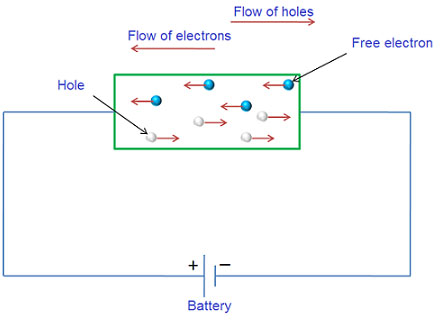
When electric field is applied across an intrinsic semiconductor, the current conduction takes place by two processes, by free electrons and holes as shown in above figure. The free electrons are generated due to the breaking up of some covalent bonds by thermal energy. At the same time, holes are created in the covalent bonds.
The electrons experience a force towards the positive terminal of the battery and the holes towards the negative terminal. The random motion of electrons and holes get modified. Over and above the random motion, there also occurs a net movement called drift.
Since the random motion of electrons or holes does not contribute to any electric current, we need not consider it. The free electrons drift towards the positive terminal of the battery and the holes towards the negative terminal. This movement of charge carriers constitute the electric current under the influence of electric field and it flows through the semiconductor in the same direction in which the holes are moving. Since the electrons are negatively charged, the direction of electric current is opposite to the direction of their motion.
Although, the two types of charge carriers move in opposite direction, the two currents are in same direction and they add together. Therefore, the total number current inside the semiconductor crystal is the sum of electric currents due to the free electrons and holes. When the flow of charge carriers is due to an applied, the resultant current is called a drift current.
